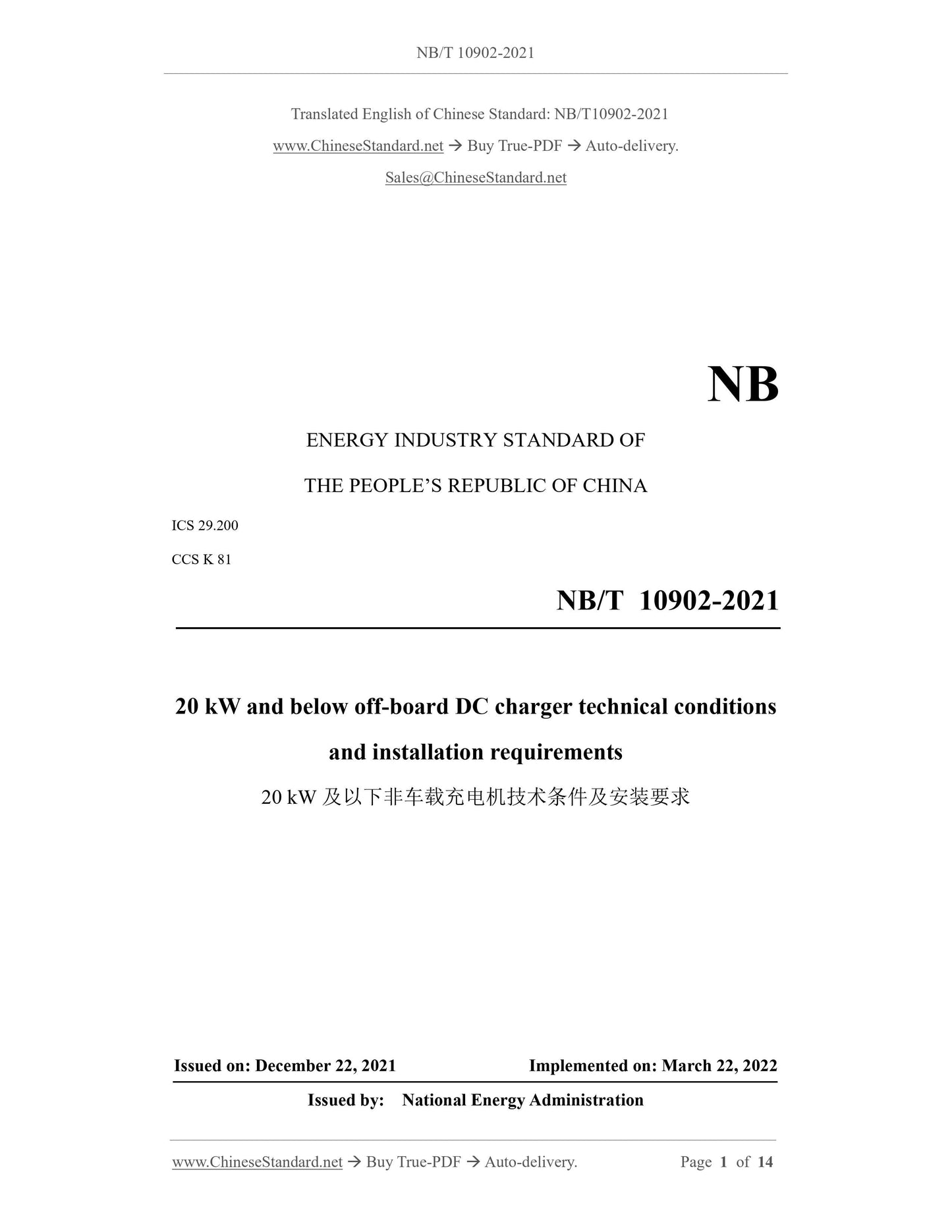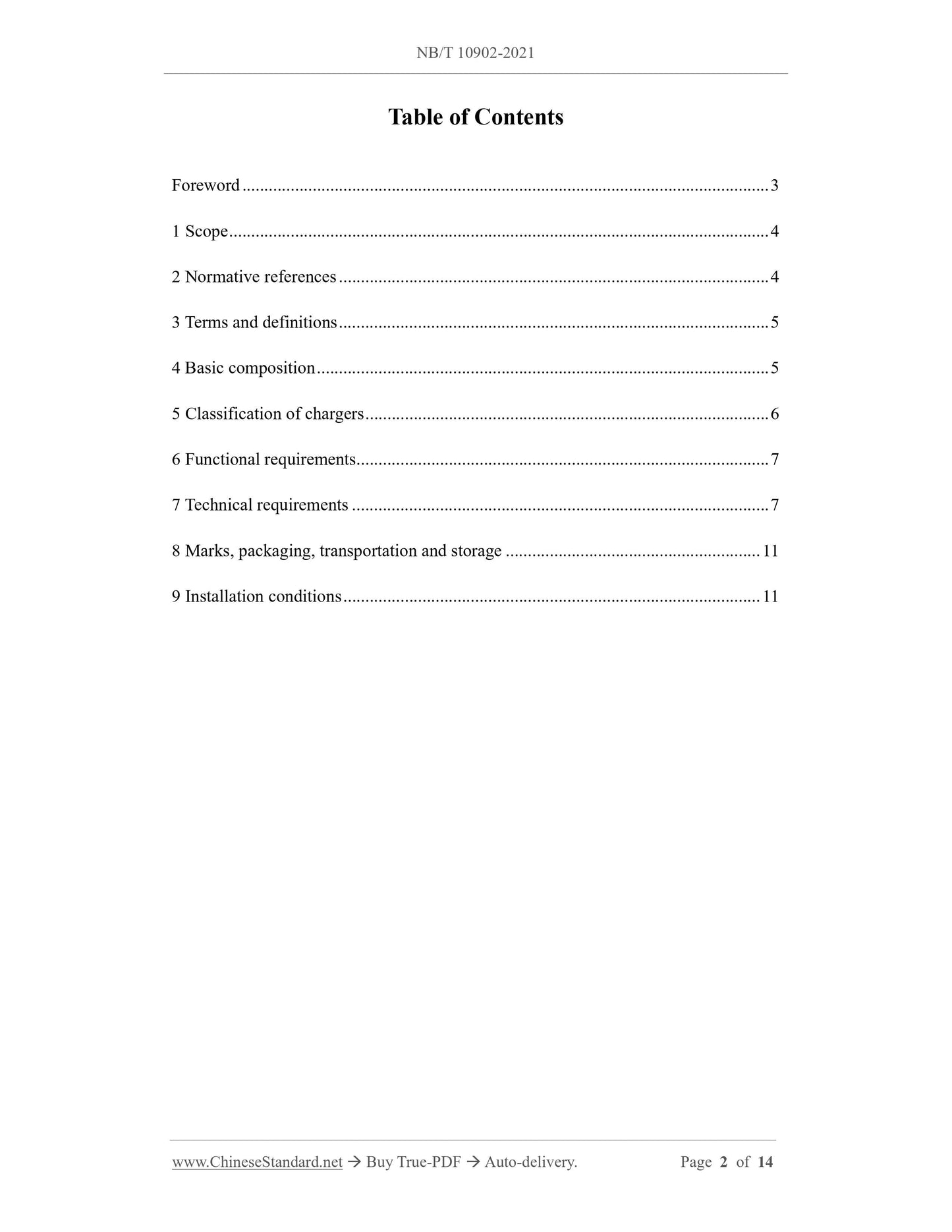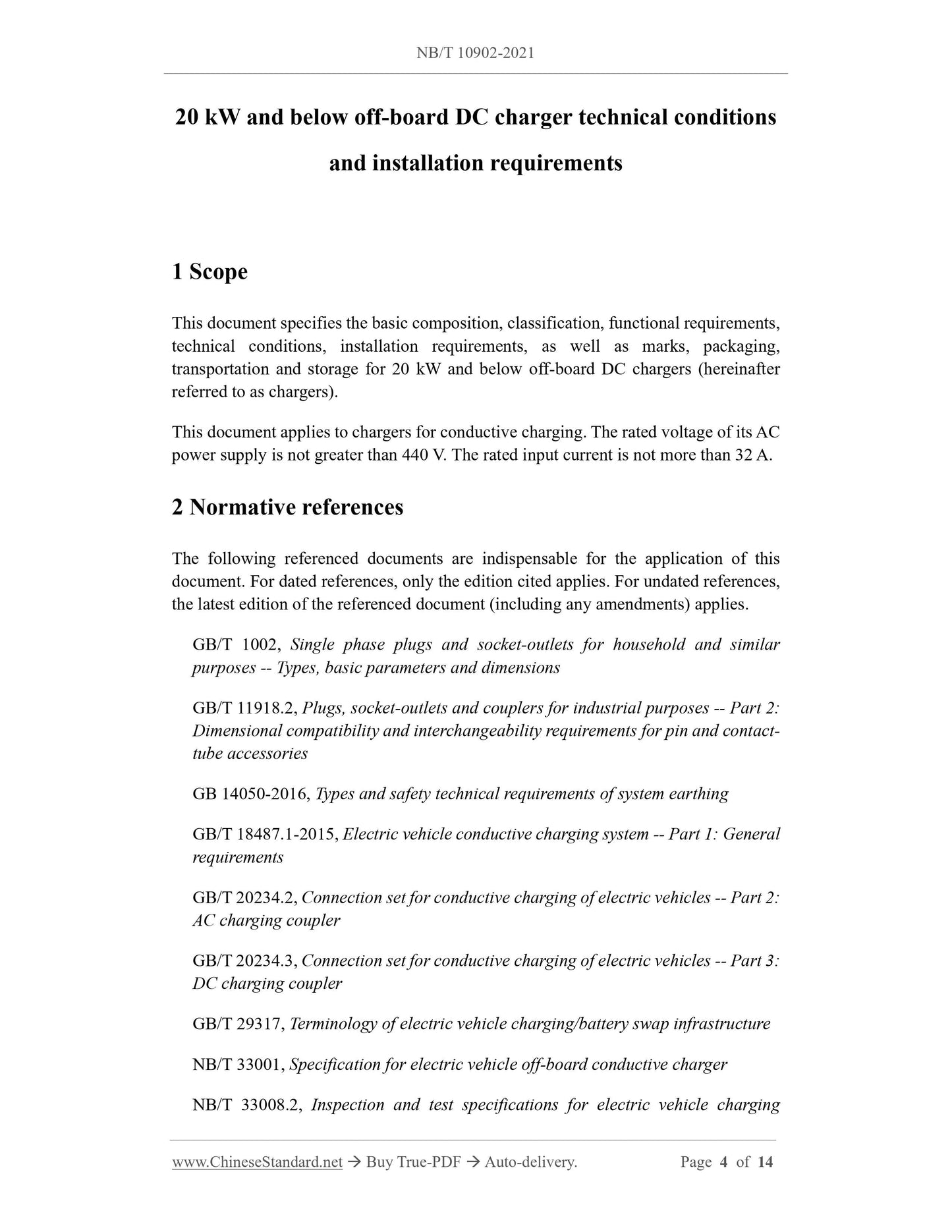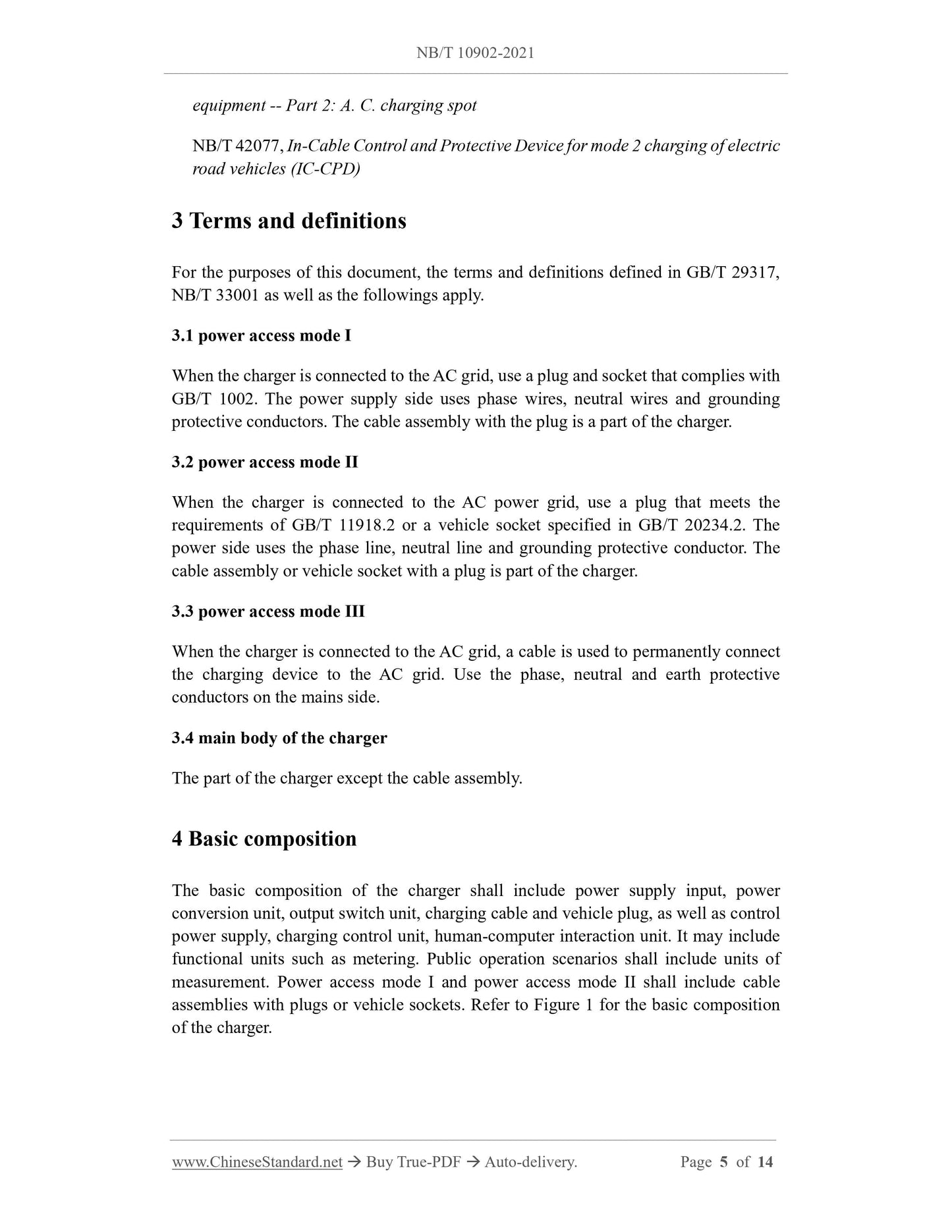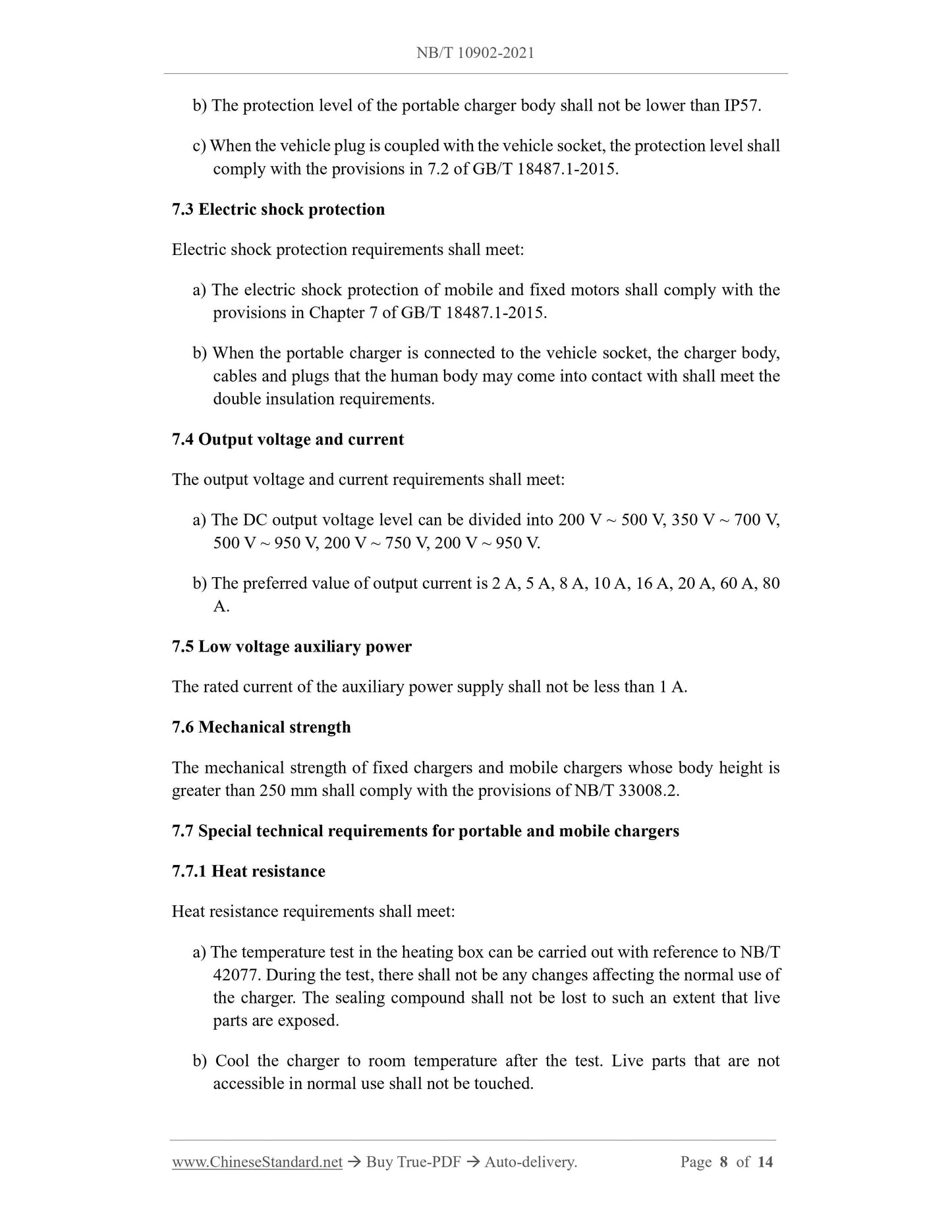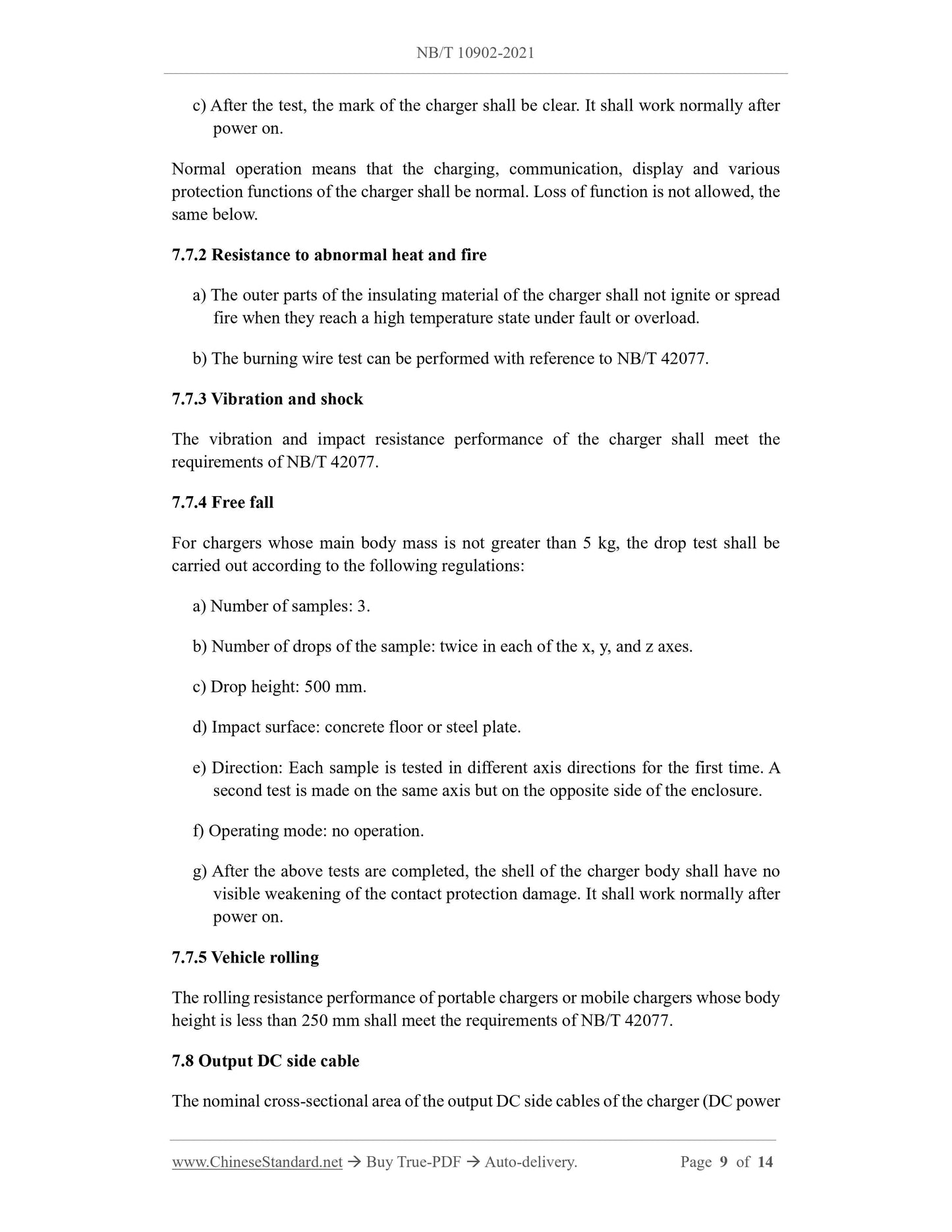1
/
of
6
PayPal, credit cards. Download editable-PDF and invoice in 1 second!
NB/T 10902-2021 English PDF (NBT10902-2021)
NB/T 10902-2021 English PDF (NBT10902-2021)
Regular price
$200.00 USD
Regular price
Sale price
$200.00 USD
Unit price
/
per
Shipping calculated at checkout.
Couldn't load pickup availability
Delivery: 3 seconds. Download true-PDF + Invoice.
Get QUOTATION in 1-minute: Click NB/T 10902-2021
Historical versions: NB/T 10902-2021
Preview True-PDF (Reload/Scroll if blank)
NB/T 10902-2021: 20 kW and below off-board DC charger technical conditions and installation requirements
NB/T 10902-2021
NB
ENERGY INDUSTRY STANDARD OF
THE PEOPLE’S REPUBLIC OF CHINA
ICS 29.200
CCS K 81
20 kW and below off-board DC charger technical conditions
and installation requirements
ISSUED ON: DECEMBER 22, 2021
IMPLEMENTED ON: MARCH 22, 2022
Issued by: National Energy Administration
Table of Contents
Foreword ... 3
1 Scope ... 4
2 Normative references ... 4
3 Terms and definitions ... 5
4 Basic composition ... 5
5 Classification of chargers ... 6
6 Functional requirements ... 7
7 Technical requirements ... 7
8 Marks, packaging, transportation and storage ... 11
9 Installation conditions ... 11
20 kW and below off-board DC charger technical conditions
and installation requirements
1 Scope
This document specifies the basic composition, classification, functional requirements,
technical conditions, installation requirements, as well as marks, packaging,
transportation and storage for 20 kW and below off-board DC chargers (hereinafter
referred to as chargers).
This document applies to chargers for conductive charging. The rated voltage of its AC
power supply is not greater than 440 V. The rated input current is not more than 32 A.
2 Normative references
The following referenced documents are indispensable for the application of this
document. For dated references, only the edition cited applies. For undated references,
the latest edition of the referenced document (including any amendments) applies.
GB/T 1002, Single phase plugs and socket-outlets for household and similar
purposes -- Types, basic parameters and dimensions
GB/T 11918.2, Plugs, socket-outlets and couplers for industrial purposes -- Part 2:
Dimensional compatibility and interchangeability requirements for pin and contact-
tube accessories
GB 14050-2016, Types and safety technical requirements of system earthing
GB/T 18487.1-2015, Electric vehicle conductive charging system -- Part 1: General
requirements
GB/T 20234.2, Connection set for conductive charging of electric vehicles -- Part 2:
AC charging coupler
GB/T 20234.3, Connection set for conductive charging of electric vehicles -- Part 3:
DC charging coupler
GB/T 29317, Terminology of electric vehicle charging/battery swap infrastructure
NB/T 33001, Specification for electric vehicle off-board conductive charger
NB/T 33008.2, Inspection and test specifications for electric vehicle charging
equipment -- Part 2: A. C. charging spot
NB/T 42077, In-Cable Control and Protective Device for mode 2 charging of electric
road vehicles (IC-CPD)
3 Terms and definitions
For the purposes of this document, the terms and definitions defined in GB/T 29317,
NB/T 33001 as well as the followings apply.
3.1 power access mode Ⅰ
When the charger is connected to the AC grid, use a plug and socket that complies with
GB/T 1002. The power supply side uses phase wires, neutral wires and grounding
protective conductors. The cable assembly with the plug is a part of the charger.
3.2 power access mode II
When the charger is connected to the AC power grid, use a plug that meets the
requirements of GB/T 11918.2 or a vehicle socket specified in GB/T 20234.2. The
power side uses the phase line, neutral line and grounding protective conductor. The
cable assembly or vehicle socket with a plug is part of the charger.
3.3 power access mode III
When the charger is connected to the AC grid, a cable is used to permanently connect
the charging device to the AC grid. Use the phase, neutral and earth protective
conductors on the mains side.
3.4 main body of the charger
The part of the charger except the cable assembly.
4 Basic composition
The basic composition of the charger shall include power supply input, power
conversion unit, output switch unit, charging cable and vehicle plug, as well as control
power supply, charging control unit, human-computer interaction unit. It may include
functional units such as metering. Public operation scenarios shall include units of
measurement. Power access mode I and power access mode II shall include cable
assemblies with plugs or vehicle sockets. Refer to Figure 1 for the basic composition
of the charger.
b) The protection level of the portable charger body shall not be lower than IP57.
c) When the vehicle plug is coupled with the vehicle socket, the protection level shall
comply with the provisions in 7.2 of GB/T 18487.1-2015.
7.3 Electric shock protection
Electric shock protection requirements shall meet:
a) The electric shock protection of mobile and fixed motors shall comply with the
provisions in Chapter 7 of GB/T 18487.1-2015.
b) When the portable charger is connected to the vehicle socket, the charger body,
cables and plugs that the human body may come into contact with shall meet the
double insulation requirements.
7.4 Output voltage and current
The output voltage and current requirements shall meet:
a) The DC output voltage level can be divided into 200 V ~ 500 V, 350 V ~ 700 V,
500 V ~ 950 V, 200 V ~ 750 V, 200 V ~ 950 V.
b) The preferred value of output current is 2 A, 5 A, 8 A, 10 A, 16 A, 20 A, 60 A, 80
A.
7.5 Low voltage auxiliary power
The rated current of the auxiliary power supply shall not be less than 1 A.
7.6 Mechanical strength
The mechanical strength of fixed chargers and mobile chargers whose body height is
greater than 250 mm shall comply with the provisions of NB/T 33008.2.
7.7 Special technical requirements for portable and mobile chargers
7.7.1 Heat resistance
Heat resistance requirements shall meet:
a) The temperature test in the heating box can be carried out with reference to NB/T
42077. During the test, there shall not be any changes affecting the normal use of
the charger. The sealing compound shall not be lost to such an extent that live
parts are exposed.
b) Cool the charger to room temperature after the test. Live parts that are not
accessible in normal use shall not be touched.
c) After the test, the mark of the charger shall be clear. It shall work normally after
power on.
Normal operation means that the charging, communication, display and various
protection functions of the charger shall be normal. Loss of function is not allowed, the
same below.
7.7.2 Resistance to abnormal heat and fire
a) The outer parts of the insulating material of the charger shall not ignite or spread
fire when they reach a high temperature state under fault or overload.
b) The burning wire test can be performed with reference to NB/T 42077.
7.7.3 Vibration and shock
The vibration and impact resistance performance of the charger shall meet the
requirements of NB/T 42077.
7.7.4 Free fall
For chargers whose main body mass is not greater than 5 kg, the drop test shall be
carried out according to the following regulations:
a) Number of samples: 3.
b) Number of drops of the sample: twice in each of the x, y, and z axes.
c) Drop height: 500 mm.
d) Impact surface: concrete floor or steel plate.
e) Direction: Each sample is tested in different axis directions for the first time. A
second test is made on the same axis but on the opposite side of the enclosure.
f) Operating mode: no operation.
g) After the above tests are completed, the shell of the charger body shall have no
visible weakening of the contact protection damage. It shall work normally after
power on.
7.7.5 Vehicle rolling
The rolling resistance performance of portable chargers or mobile chargers whose body <...
Get QUOTATION in 1-minute: Click NB/T 10902-2021
Historical versions: NB/T 10902-2021
Preview True-PDF (Reload/Scroll if blank)
NB/T 10902-2021: 20 kW and below off-board DC charger technical conditions and installation requirements
NB/T 10902-2021
NB
ENERGY INDUSTRY STANDARD OF
THE PEOPLE’S REPUBLIC OF CHINA
ICS 29.200
CCS K 81
20 kW and below off-board DC charger technical conditions
and installation requirements
ISSUED ON: DECEMBER 22, 2021
IMPLEMENTED ON: MARCH 22, 2022
Issued by: National Energy Administration
Table of Contents
Foreword ... 3
1 Scope ... 4
2 Normative references ... 4
3 Terms and definitions ... 5
4 Basic composition ... 5
5 Classification of chargers ... 6
6 Functional requirements ... 7
7 Technical requirements ... 7
8 Marks, packaging, transportation and storage ... 11
9 Installation conditions ... 11
20 kW and below off-board DC charger technical conditions
and installation requirements
1 Scope
This document specifies the basic composition, classification, functional requirements,
technical conditions, installation requirements, as well as marks, packaging,
transportation and storage for 20 kW and below off-board DC chargers (hereinafter
referred to as chargers).
This document applies to chargers for conductive charging. The rated voltage of its AC
power supply is not greater than 440 V. The rated input current is not more than 32 A.
2 Normative references
The following referenced documents are indispensable for the application of this
document. For dated references, only the edition cited applies. For undated references,
the latest edition of the referenced document (including any amendments) applies.
GB/T 1002, Single phase plugs and socket-outlets for household and similar
purposes -- Types, basic parameters and dimensions
GB/T 11918.2, Plugs, socket-outlets and couplers for industrial purposes -- Part 2:
Dimensional compatibility and interchangeability requirements for pin and contact-
tube accessories
GB 14050-2016, Types and safety technical requirements of system earthing
GB/T 18487.1-2015, Electric vehicle conductive charging system -- Part 1: General
requirements
GB/T 20234.2, Connection set for conductive charging of electric vehicles -- Part 2:
AC charging coupler
GB/T 20234.3, Connection set for conductive charging of electric vehicles -- Part 3:
DC charging coupler
GB/T 29317, Terminology of electric vehicle charging/battery swap infrastructure
NB/T 33001, Specification for electric vehicle off-board conductive charger
NB/T 33008.2, Inspection and test specifications for electric vehicle charging
equipment -- Part 2: A. C. charging spot
NB/T 42077, In-Cable Control and Protective Device for mode 2 charging of electric
road vehicles (IC-CPD)
3 Terms and definitions
For the purposes of this document, the terms and definitions defined in GB/T 29317,
NB/T 33001 as well as the followings apply.
3.1 power access mode Ⅰ
When the charger is connected to the AC grid, use a plug and socket that complies with
GB/T 1002. The power supply side uses phase wires, neutral wires and grounding
protective conductors. The cable assembly with the plug is a part of the charger.
3.2 power access mode II
When the charger is connected to the AC power grid, use a plug that meets the
requirements of GB/T 11918.2 or a vehicle socket specified in GB/T 20234.2. The
power side uses the phase line, neutral line and grounding protective conductor. The
cable assembly or vehicle socket with a plug is part of the charger.
3.3 power access mode III
When the charger is connected to the AC grid, a cable is used to permanently connect
the charging device to the AC grid. Use the phase, neutral and earth protective
conductors on the mains side.
3.4 main body of the charger
The part of the charger except the cable assembly.
4 Basic composition
The basic composition of the charger shall include power supply input, power
conversion unit, output switch unit, charging cable and vehicle plug, as well as control
power supply, charging control unit, human-computer interaction unit. It may include
functional units such as metering. Public operation scenarios shall include units of
measurement. Power access mode I and power access mode II shall include cable
assemblies with plugs or vehicle sockets. Refer to Figure 1 for the basic composition
of the charger.
b) The protection level of the portable charger body shall not be lower than IP57.
c) When the vehicle plug is coupled with the vehicle socket, the protection level shall
comply with the provisions in 7.2 of GB/T 18487.1-2015.
7.3 Electric shock protection
Electric shock protection requirements shall meet:
a) The electric shock protection of mobile and fixed motors shall comply with the
provisions in Chapter 7 of GB/T 18487.1-2015.
b) When the portable charger is connected to the vehicle socket, the charger body,
cables and plugs that the human body may come into contact with shall meet the
double insulation requirements.
7.4 Output voltage and current
The output voltage and current requirements shall meet:
a) The DC output voltage level can be divided into 200 V ~ 500 V, 350 V ~ 700 V,
500 V ~ 950 V, 200 V ~ 750 V, 200 V ~ 950 V.
b) The preferred value of output current is 2 A, 5 A, 8 A, 10 A, 16 A, 20 A, 60 A, 80
A.
7.5 Low voltage auxiliary power
The rated current of the auxiliary power supply shall not be less than 1 A.
7.6 Mechanical strength
The mechanical strength of fixed chargers and mobile chargers whose body height is
greater than 250 mm shall comply with the provisions of NB/T 33008.2.
7.7 Special technical requirements for portable and mobile chargers
7.7.1 Heat resistance
Heat resistance requirements shall meet:
a) The temperature test in the heating box can be carried out with reference to NB/T
42077. During the test, there shall not be any changes affecting the normal use of
the charger. The sealing compound shall not be lost to such an extent that live
parts are exposed.
b) Cool the charger to room temperature after the test. Live parts that are not
accessible in normal use shall not be touched.
c) After the test, the mark of the charger shall be clear. It shall work normally after
power on.
Normal operation means that the charging, communication, display and various
protection functions of the charger shall be normal. Loss of function is not allowed, the
same below.
7.7.2 Resistance to abnormal heat and fire
a) The outer parts of the insulating material of the charger shall not ignite or spread
fire when they reach a high temperature state under fault or overload.
b) The burning wire test can be performed with reference to NB/T 42077.
7.7.3 Vibration and shock
The vibration and impact resistance performance of the charger shall meet the
requirements of NB/T 42077.
7.7.4 Free fall
For chargers whose main body mass is not greater than 5 kg, the drop test shall be
carried out according to the following regulations:
a) Number of samples: 3.
b) Number of drops of the sample: twice in each of the x, y, and z axes.
c) Drop height: 500 mm.
d) Impact surface: concrete floor or steel plate.
e) Direction: Each sample is tested in different axis directions for the first time. A
second test is made on the same axis but on the opposite side of the enclosure.
f) Operating mode: no operation.
g) After the above tests are completed, the shell of the charger body shall have no
visible weakening of the contact protection damage. It shall work normally after
power on.
7.7.5 Vehicle rolling
The rolling resistance performance of portable chargers or mobile chargers whose body <...
Share
